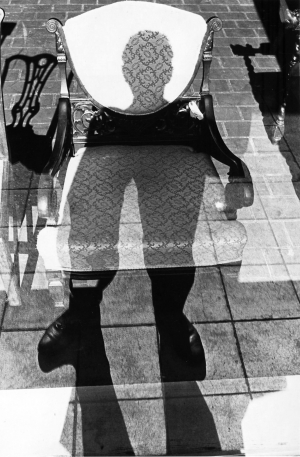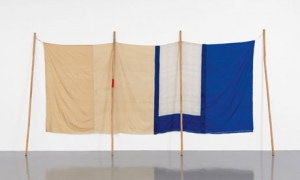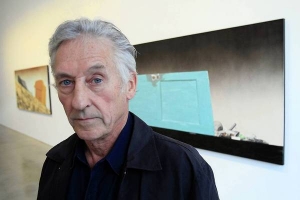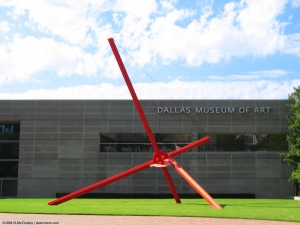|
Displaying items by tag: San Francisco Museum of Modern Art

The San Francisco Museum of Modern Art (SFMOMA) announced that in 2016, it will unveil its John and Lisa Pritzker Center for Photography. It will be the largest exhibition space for photography in the United States. The museum is in the midst of a considerable expansion, which is being helmed by Snøhetta, a firm with headquarters in Norway and New York. The $365 million project will double the size of the museum.
The Pritzker Center for Photography is being funded by a lead gift from philanthropists and photography collectors, John and Lisa Pritzker, as well as generous donations from four additional benefactors. The nearly 15,500-square-foot center will just about triple the current amount of space for photography at SFMOMA. In addition to increased exhibition space, the center will feature an upgraded photographic study center and an interpretive space that will be the first of its kind in the country.
SFMOMA’s photography holdings currently number some 17,000 objects -- its largest collection in any medium. The collection includes works by Edward Weston, Alfred Stieglitz, Ansel Adams, Dorothea Lange, Man Ray, William Eggleston, Lee Friedlander, and the finest holdings of Japanese photography outside Japan. SFMOMA’s photography collection will live on-site, divided between two state-of-the-art storage vault.
The museum’s director, Neal Benezra, said, ““The new center, together with the gifts to our collection, represent a transformative development for our photography program and for the entire museum. We are extremely grateful to our trustee Lisa Pritzker and her husband, John, and to our other supporters, whose vision and generosity will make SFMOMA a global destination for anyone with an interest in photography.”

The Robert Rauschenberg Foundation announced that six American museums have acquired works by Robert Rauschenberg thank to its Gift/Purchase Program. The program was designed to expand public access to and awareness of Rauschenberg’s work by offering institutions the opportunity to acquire artworks from the foundation’s collection through equal parts gift and purchase.
The Metropolitan Museum of Art in New York acquired “Bande de Surete/Twin City/Nipples (Cardboard)” and “Vow (Jammers);” The Minneapolis Institute of Arts in Minnesota gained “Park/ROCI MEXICO;” the Museum of Modern Art in New York obtained “Nabisco Shredded Wheat (Cardboard),” “Gull (Jammer),” and “Stop Side Early Winter (Glut);” The New Orleans Museum of Art in Louisiana acquired “Melic Meeting (Spread);” The San Francisco Museum of Modern Art in California gained “Rosalie/Red Cheek/Temporary Letter/Stock (Cardboard);” and the Solomon R. Guggenheim Museum in New York obtained “Untitled (Venetian).”
The works, which were created across two decades, are from some of Rauschenberg’s most important series. His Cardboards explore the aesthetic potential of everyday materials; the Venetians are sculptural works reminiscent of the Italian city’s atmosphere; Jammers, which were inspired by a trip to India, celebrate the sensual qualities of fabric; Spreads are large-scale works that combine printed imagery and found objects; Gluts touch on socioeconomic issues; and the artist’s ROCI series was created as part of a humanitarian project that promoted world peace through artistic dialogue with local cultures.
Rauschenberg, who helped bridge the gap between Abstract Expressionism and Pop art, was a pioneering figure in 20th century art. He is best known for his “Combines,” which are part painting and part sculpture. Rauschenberg often used found objects and non-traditional materials in these works.

When the San Francisco Museum of Modern Art opens its new building to the public in 2016, its free admission policy will expand from visitors 12-years-old and under to 18 and under. The initiative was spurred by the museum’s commitment to inspire more young people by promoting intimate art experiences and is intended to encourage repeat visits by Bay Area youths. The expansion is expected to result in as many as 30,000 additional visitors annually between the ages of 13 and 18.
The updated free admission policy was made possible in part by a $5 million donation from Arthur Rock and Toni Rembe Rock. Following the Rocks’ major gift, SFMOMA succeeded in raising the total $10 million endowment required to ensure free admission to the museum’s young visitors. The additional $5 million was donated by Maryellie and Rupert Johnson, Harriet Heyman and Sir Michael Moritz, Lisa and John Pritzker, Irwin and Concepcion Federman, and Patricia W. Fitzpatrick.
Grant donor Arthur Rock, said, “It’s an honor to be able to further the Bay Area community’s ability to experience all that SFMOMA has to offer. The museum is an indispensable educational resource and an aid to personal development that must be provided to our children barrier-free.”

After leaving the Los Angeles Museum of Contemporary Art’s (MOCA) board last year, California-based artist Ed Ruscha will join the San Francisco Museum of Art’s (SFMOMA) board. SFMOMA announced on Thursday, August 15, 2013 that Ruscha will take the one spot on its board reserved for an artist. He will serve on the board for a three-year term.
Ruscha has a profound relationship with SFMOMA and the museum is one of the few institutions in the world to have a complete collection of his seminal artist books, which he began making in the 1960s. SFMOMA also hosted Ruscha’s first retrospective in 1982. SFMOMA’s director, Neal Benezra, said, “Given his long history with SFMOMA and his exceptional knowledge and great influence in the art world, [Ruscha’s] input will be invaluable as we dramatically expand to become an international showcase for the best in contemporary culture.”
SFMOMA is in the midst of a $160-million renovation and expansion. Its central building is closed until at least early 2016.
The San Francisco Museum of Modern Art presents 8 large-scale steel sculptures by Mark di Suvero (b. 1933) at historic Crissy Field for a free, yearlong exhibition. Organized in partnership with the National Park Service and the Golden Gate National Parks, the exhibition kicks off an extensive program of off-site exhibitions that SFMOMA will offer while the museum is undergoing a massive renovation and expansion. The museum is slated to re-open in early 2016.
Mark di Suvero at Crissy Field spans 5 decades of the artist’s career and coincides with di Suvero’s 80th birthday. The exhibition, which includes one never-before-seen sculpture, is the largest survey of the artist’s work ever presented on the west coast. Crissy Field offers striking views of the Golden Gate Bridge, which has long been a source of inspiration for di Suvero who immigrated to San Francisco from Shanghai as a child.
Mark di Suvero at Crissy Field will be on view through May 26, 2014.

San Francisco’s Museum of Modern Art (SFMOMA) broke ground on its highly anticipated expansion on Wednesday, May 29, 2013. Around 300 supporters gathered to witness the kick-off of the construction project that will add 225,000-square-feet to the museum. The renovated space is expected to reopen in 2016.
Snøhetta, an international architecture, landscape architecture, and interior design firm based in Oslo, Norway and New York City, designed SFMOMA’s expansion, which is expected to cost around $610 million. 89% of the capital has already been collected through fundraising. Officials upped their original estimate for construction from $555 million in May.
SFMOMA’s expansion will more than double the existing exhibition space and provide nearly six times as much public space as their currently Mario Botta-designed building. The renovation will create a new outdoor terrace, a sculpture terrace, and state-of-the-art conservation studios. The museum will also take a more environmentally sensitive approach to day-to-day operations. SFMOMA hopes to gain LEED Gold certification by reducing their energy costs, water use, and wastewater generation.

When the San Francisco Museum of Modern Art closes on June 2, 2013 for three years worth of renovations and an expansion, the institution will send some of its treasured holdings away. 23 masterpieces by Henri Matisse (1869-1954) won’t have far to travel as they will be exhibited at the Legion of Honor, San Francisco’s museum of European paintings and sculpture.
The Matisse works headed to the Legion of Honor include 16 paintings, 4 sculptures, and 3 works on paper, which will hang in one of the museum’s ground-floor galleries alongside two paintings already in the Legion’s collection. The only Matisse painting that will remain off view is Femme au Chapeau (1905) as the terms of its bequest by philanthropist Elise S. Haas state that the painting cannot travel.
Although details are still vague, the Legion of Honor will host two relevant shows while exhibiting the Matisse works – one will be a retrospective of Matisse’s older contemporary, Anders Zorn (1860-1920), and the other will be a survey of French paintings on loan from the National Gallery of Art in Washington, D.C.

The Dallas Museum of Art announced today that it will nullify its $10 general admission fee, effective January 21, 2013. The museum will also launch an online rewards program that could even make membership free.
In recent years, many institutions have reversed their decision to charge visitors and are now free to the public. The Nelson-Atkins Museum of Art in Kansas City, Missouri, the Indianapolis Museum of Art, the Baltimore Museum of Art, the Walters Museum of Art in Baltimore, and the Detroit Institute of the Arts have all decided that free admission will help their institutions become more widely accessible, which, in turn, will keep visitor numbers up.
While it appears that the aforementioned museums have started a trend, many institutions in major tourist destinations are not so quick to jump on the free entry bandwagon. In New York, the Museum of Modern Art charges $25 and the Guggenheim Museum charges $22. San Francisco’s Museum of Modern Art, another major tourist attraction, charges $18. Other big-name museums that require visitors to pay are the Los Angeles County Museum of Art, the Art Institute of Chicago, the Philadelphia Museum of Art, and the Carnegie Museum of Art.

San Francisco has recently hired its very own art detective and announced a moratorium on public art donations to the city, all in response to claims that portions of a $90 million art collection have gone missing from the city's collection, according to a California Watch article.
A Civil Grand Jury report released last month admonished the San Francisco Arts Commission for mismanaging the city's valuables after it discovered that portions of the 4,000-piece public art collection were nowhere to be found. The jury put a spotlight on the Commission's inventory practices, stating that the city's art remains only partially counted and exposed to neglect.
Just how large the missing portions are is unknown, but a Bay Citizen article from 2011 cites a few concrete examples of the city's loss, stating that 141 items from a 1972 acquisition of 496 pieces meant to be housed in San Francisco General hospital have yet to be located and 19 of the city's 58 pieces of modernist jewelry are tentatively missing.
The current public art collection consists of sculptures and monuments as well as 2,500 paintings and other movable works that have spent time on the facades of public buildings. With items ranging in value from Edvard Munch's lithographs to local artisan craft works, it is a vast inventory of works that has grown since the initial 1969 Art Enrichment Ordinance that mandated two percent of public works contracts be allocated toward public art. The arts commission still has sufficient funds to add to the already massive collection, yet the collection has only two staff members in charge of tending to its growth and maintenance. This, according to the Civil Grand Jury's report, may be a reason why a significant portion of the collection has gone missing.
|
|
|
|
|